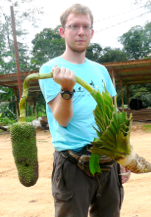
phone: +32 (0)2 650 45 14
e-mail: gildauby@gmail.com
Post-doctoral project

My main research interests are:
-
•Testing the relative importance of ecological gradients and historical contingency for explaining the distribution of species within and among plant communities and of genetic lineages within and among populations. Models are tree species of central African rainforests.
-
•Evaluate the ability of various metrics of phylogenetic structure for inferring processes from patterns using an individual-based spatially explicit community model.
I am also deeply involved into the RAINBIO project.
RAINBIO has a double objective in Tropical Africa:
-
1.To produce an open access mega database of accurate tropical plant distributions. This database has been compiled from existing public and personal datasets made available through the consortium, and comprise more than 600,000 records for more than 24,000 vascular plant species.

-
2.To use this mega-database for describing and explaining large scale floristic and diversity patterns.
-
3.To use this mega-database for re-defining phytogeographical delimitations in Tropical Africa.
-
4.To use this mega-database for modeling species distributions at several time intervals (past and future) using species distribution modelling and past and future climate scenarios.
Publications

See Google scholar website or ResearchGate profile.
Thesis

Structuration spatiale de la diversité intra- et interspecifique en Afrique centrale
Supervisors: O. Hardy and T. Stévart
The relative importance of historical, stochastic and deterministic factors on the spatial structure of species diversity (SSDS) in the central African forests has been highly debated. The SSDS is moreover still not well characterized, particularly the spatial variation of community composition (beta diversity).
One hypothesis often evoked regarding the origin of the centres of diversity and endemism is historical: these centres could have been forest refuges during dry climatic periods of the Quaternary. However, the high level of environmental heterogeneity in these regions could equally explain the SSDS.
The main goal of my thesis was to weight the relative importance of these factors. If historical factors are determinants, a spatial congruence between the SSDS and the spatial structure of within-species diversity (SSDG) should be observed. The variability of neutral genetic structure within species is indeed largely controlled by processes that affect equally the SSDS (genetic/ecological drift and gene flow/species dispersal). The approach used was therefore to compare and evaluate the spatial congruence between the SSDS and the SSDG.
The biological model and the geographical frame of this study were communities and populations of tree species within moist Atlantic Central African forests, with a special focus on Gabonese forests. The SSDS was studied on the basis of standardized inventories of tree communities (16.308 individuals) whereas the SSDG was characterized on the basis of chloroplastic DNA sequences of six tree species (Greenwayodendron suaveolens, Scorodophloeus zenkeri, Afrostyrax lepidophyllus, Afrostyrax kamerunensis, Santiria trimera and Erythrophleum suaveolens).
Four specific aims had been defined: (i) Develop a methodological framework allowing the estimation of the SSDS and evaluate its statistical performance when the diversity is estimated by community samples; (ii) Quantify the SSDS and evaluate the impact of environmental gradients; (iii) Test the spatial congruence of SSDG among the six tree species; and (iv) Evaluate the spatial concordance between SSDS and SSDG.
Educational background

-
•2006-2007: Diplôme d’Etudes approfondies (ULB), botanique
-
•2005-2006: Licencié en sciences biologiques (ULB), orientation biologie végétale
















